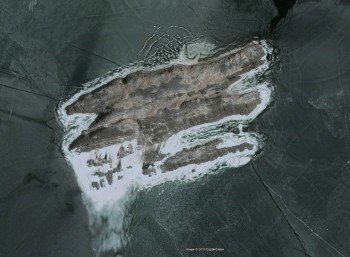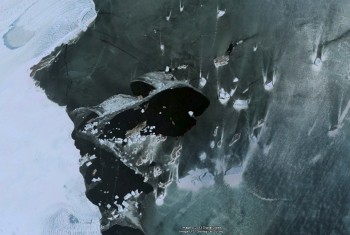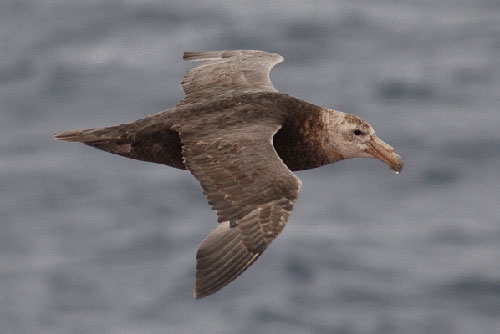
Giganteus Island
Giganteus Island, part of the Rookery Islands in Mac.Robertson Land, East Antarctica is one of the only four known breeding localities for Southern Giant Petrels Macronectes giganteus along the coast of continental Antarctica (i.e away from the Antarctic Peninsula). The number of occupied nests on the island decreased rapidly from the late 1950s/early 1960s when there were perhaps 15-25 breeding pairs (maximum count 13 eggs in 1962). There appears to have been an initial marked decrease on Giganteus Island followed by a long period of relative stability: only three occupied nests were recorded in 2007. The reasons for the historical decrease are uncertain.

The Rookery Islands
The Rookery Islands comprise a group of c. 75 small islands and rocks in Holme Bay, some 10 kilometres west of the Australia’s Antarctic station of Mawson. They are an Antarctic Specially Protected Area (ASPA No. 102) as proclaimed by the Antarctic Treaty System. Giganteus Island has been designated as a restricted zone within the ASPA to afford a high level of protection to its Southern Giant Petrel population. Permits to enter the Giganteus Island Restricted Zone during the breeding period (1October to 30 April) may only be issued for the purpose of conducting censuses of the giant petrels.
Inter alia the management plan for the Rookery Islands aims to:
minimise human disturbance to Southern Giant Petrels on Giganteus Island;
allow Giganteus Island to be used as a reference area for future comparative studies with other breeding populations of Southern Giant Petrels; and
preserve Giganteus Island, as a highly-restricted area by limiting human visitation during the Southern Giant Petrel breeding season.
The management plan further states that “where practicable, at least one research visit should be conducted to census [sic] the Southern Giant Petrels at Giganteus Island and other seabird populations in each five year period, to enable assessment of breeding populations.”
Southern Giant Petrels on the Antarctic Continent away from the Antarctic Peninsula comprise less than 1% of the species’ global breeding population.
The last visit made to Giganteus was in December 2008: three pairs and one single giant petrel were sighted. If possible, the Australian Antarctic Division will try to get a team onto the island in the coming season.
Click here for the ACAP Breeding Site account for Hawker Island, another Southern Giant Petrel breeding locality in East Antarctica.
Click here to access the ACAP Species Assessment for the Southern Giant Petrel.

Southern Giant Petrel. Photograph by Warwick Barnes
Selected References:
Department of Sustainability, Environment, Water, Population and Communities 2011. National Recovery Plan for Threatened Albatrosses and Giant Petrels 2011-2016. Hobart: Australian Antarctic Division, Commonwealth Department of Sustainability, Environment, Water, Population and Communities. 30 pp.
Patterson, D.L., Woehler, E.J., Croxall, J.P., Cooper, J., Poncet, S. & Fraser, W.R. 2008. Breeding distribution and population status of the Northern Giant Petrel Macronectes halli and the Southern Giant Petrel M. giganteus. Marine Ornithology 36: 115-124.
Wienecke, B., Leaper, R., Hay, I. & van den Hoff, J. 2009. Retrofitting historical data in population studies: southern giant petrels in the Australian Antarctic Territory. Endangered Species Research 8: 157-164.
Woehler, E.J. & Johnstone, G.W. 1991. Status and conservation of seabirds of the Australian Antarctic Territory. In: Croxall, J.P. (Ed.). Seabird Status and Conservation: a Supplement. International Council for Bird Preservation Technical Publication No. 11. pp. 279-308.
Woehler, E.J., Riddle, M.J. & Ribic, C.A. 2003. Long-term population trends in southern giant petrels in East Antarctica. In: Huiskes, A.H.L., Gieskes, W.W.C., Rozema, J., Schorno, R.M.L., van der Vies, S.M. & Wolff, W.J. (Eds). Antarctic Biology in a Global Context. Leiden: Backhuys Publishers. pp. 290-295.
John Cooper, ACAP Information Officer & Barbara Wienecke, Australian Antarctic Division, Kingston, Tasmania, 1 June 2013

 English
English  Français
Français  Español
Español